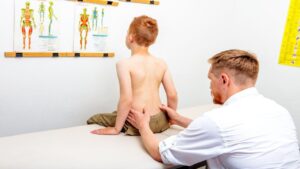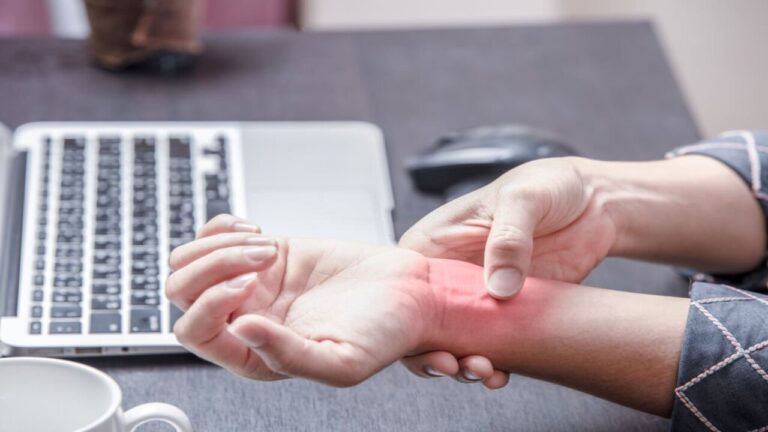According to Johns Hopkins Medicine, the cause of scoliosis is unknown in more than 80% of cases. Family history, osteoporosis, arthritis, and the degeneration of spinal discs are contributing factors to this condition in a minority of instances. Even though scoliosis doesn’t have a cure, there are treatments that can help manage the symptoms.
At Naples Community Injury Center, we may prescribe you to undergo different chiropractic adjustments and physiotherapy methods that enable you to cope with your scoliosis. The treatments we recommend will depend on the nature of your scoliosis, your pain levels, and how it affects your day-to-day life. You can book an appointment with our team today when you dial (239) 631-5445.
What Is Scoliosis?

Rectangular discs called vertebrae make up our spine, and a healthy spine is straight and centered. When the spine is curved in the shape of a “C” or “S,” it may appear that a person is leaning to one side more than the other, which may be a sign of scoliosis. Mayo Clinic affirms that other symptoms may include:
- Shoulders at different height
- One shoulder blade juts out more than the other
- Uneven waist
- The head is off-center
- One side of the rib cage is more prominent than the other
- One hip is higher than the other
- One side of the back juts out more when bending down
We can only diagnose you with scoliosis when we take an X-ray of your spine or conduct a physical examination. If the curvature of the spine is 10 degrees or more, you may have scoliosis. Most cases of scoliosis are mild, but the curvatures of the spine tend to worsen with age. That’s why when scoliosis is diagnosed in children, physicians tend to actively monitor their condition. Usually, they just need to wear a brace. Sometimes the doctors may recommend more extreme measures, though.
Severe cases of scoliosis can be debilitating, as the more extreme the curve of the spine is, the less space in the chest there is, which can impair lung function.
Types of Scoliosis
John Hopkins Medicine states that the medical community has classified scoliosis into three different categories:
- Congenital scoliosis: Misshapen vertebrae leads to spinal curvature. A doctor may diagnose this condition in early infancy, but it’s normal to spot it later in childhood, as well. Congenital scoliosis tends to worsen with age, but physicians may take the “watch and wait” approach to determine the best way to treat this form of scoliosis.
- Idiopathic scoliosis: Even with decades of studying this type of scoliosis, the medical community still cannot identify the cause of idiopathic scoliosis. It usually starts developing at the beginning of adolescence and gets worse with growth.
- Neuromuscular scoliosis: Children with a neuromuscular condition, like cerebral palsy and muscular dystrophy, are at a high risk of developing neuromuscular scoliosis since their muscles are already unbalanced and weak. Wearing a brace may help slow the progression, but should the curvature go beyond 50 degrees, surgery may be necessary.
After we evaluate your condition, our team of physicians can construct a treatment plan that is unique to your body, needs, and goals.
Treatments We Render for Scoliosis Patients

We may incorporate chiropractic care, specifically spinal manipulations, into your scoliosis treatment regimen. Here, we use our hands or a handheld tool to gently force your spine back to realignment. If your condition causes you any pain or discomfort, you should feel some relief right away. Depending on how well you respond to this method, we will administer spinal manipulations for the next few sessions.
We can also introduce physiotherapy techniques to help you enhance your flexibility, regain your strength, and further heal inflammation. For example, we may have you see our massage therapist. During a session, they will use pressure to relieve muscle tension and create more spaces between joints.
Once you’re feeling good and relaxed, we will teach you different stretches and strengthening exercises to help maintain your new condition. You should be able to practice some, if not all, of them at home.
How You Feel Throughout Your Scoliosis Treatment Is Important
Should you ever feel uncomfortable with any part of your treatment, let us know as soon as possible. Of course, you may experience flare-ups from time to time. That’s completely normal, but if it becomes more of a regular thing, that may be a sign that it’s time to change a part of your treatment plan.
How Naples Community Injury Center Diagnoses Scoliosis in Our Patients
In general, we take X-rays to determine whether someone has scoliosis. However, we can use other tests to help us arrive at a diagnosis, such as:
- The Adam’s Forward Bend Test: We’ll have you bend forward at the waist with your knees straight and your hands reaching toward the ground. This method can tell us if you have scoliosis in your middle or lower back.
- The Cobb Angle Measurement Test: Using an X-ray, we’ll measure the distance between the two biggest curvatures in the spine. Not only does this test help us see if you have scoliosis, but it will also give us insight into how well you can rotate your torso.
- Scoliometer: We will place a scoliometer on your back to see how well your body can twist and how asymmetrical it is. The angle of your torso’s rotation, as well as having an angle of five degrees or more, will determine whether you have scoliosis.
Call Naples Community Injury Center to Begin Your Scoliosis Treatment Today
Living with scoliosis can impede your mobility and even alter your appearance, depending on the severity of your condition. You don’t have to continue to put up with being uncomfortable when you’re sitting or standing for too long. Naples Community Injury Center is here to create a treatment plan that helps to straighten your spine and enables you to move freely. You can learn more during your first appointment with our team. Call us today at (239) 631-5445 to set one up.







